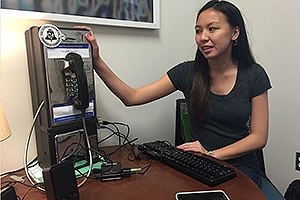Technology
Dial One to Connect

It’s just a guess, but it’s possible that many millennial-generation American University students have never used a payphone. During their formative years, cell phones were all-but-ubiquitous. Yet Eleanor Wright remembers using a payphone, as she didn’t get her first smart phone until college.
Years later, Wright maintains a curiosity towards the 20th century artifact. In fact, the computer science major has a special interest in the relationship between new and old technologies. So Wright’s capstone project seems apropos, as she programmed a traditional payphone into a game hub that enables text interaction with mobile phones.
“I always gravitate towards the unconventional uses of technology—especially those that really can have a significant cultural impact,” says Wright, a rising senior at AU. “The overarching focus of my research was finding innovative ways to connect the physical and digital world, especially for games and community enhancing projects. With these ideas in mind, I ultimately ended up reconstructing the old payphone into a gaming hub for a global civic engagement network.”
The Call Comes In…
AU School of Communication assistant professor Benjamin Stokes is a co-founder of the Leimert Phone Company, an artist collaborative that aims to repurpose payphones in the digital age. He spoke to one of Wright’s classes about his work, and she immediately expressed interest.
“With the rapid innovations in technology today, more and more technology is becoming obsolete. And I still think there’s a place for old technology in the modern world,” Wright says. This project “makes it fun for people to interact and understand the role of the old technology and the new technology in our lives.”
Technology and the Interactive Experience
This project became her computer science capstone, with Stokes serving as a mentor. Wright programmed the payphone so it can send texts to a mobile phone, or multiple texts to multiple cell phones. When you pick up the handset, an audio recording begins talking to the user about menu options. If you call into the payphone, it can even take a voicemail.
“The irony is we’ve almost turned the payphone into a mobile phone,” says Stokes.
The payphone also presented unique technological challenges. They ended up plugging an Ethernet cable into the payphone. And, for this non-standard computer to live on the AU network, IT had to make sure it didn’t have viruses.
Numerous Possibilities
In many ways, this is just the beginning. Stokes teaches in the AU Game Lab, and he specializes in how games in urban spaces help strengthen communities. This payphone, he feels, can open up numerous possibilities for gaming and engagement.
“What she built is the start of something that can go in 50 directions,” he says.
Say you’re playing a game with a group on campus. The payphone can text people on their mobile phones that the game has just begun. Maybe they’re asked to come back to the payphone—which could literally be on the AU quad—for additional audio instructions. The payphone could send a participant to a historic site in Washington. Perhaps one player is encouraged to collaborate with another player on a scavenger hunt.
“Games get people moving around, and making decisions. It’s about seeing if you made the right choice or the wrong choice, and then seeing if you can get better at it,” says Stokes.
In August, Stokes will present this work as part of a participatory design conference in Denmark. This fall, he’s teaching a class called “Playful City,” and students will design curriculum-oriented games for the payphone. The course will be for upper level undergrads and graduate students in game design.
An Eclectic Mind
It’s pretty remarkable, Stokes notes, that an undergrad built something that graduate students will utilize in class. “She did exceptional work,” Stokes says.
Wright’s academic pursuits reflect a well-rounded, talented student. Her computer science major comes with an international business concentration. She’s on the road to becoming trilingual, as she’s minoring in Chinese language and getting a Spanish translation certificate.
Wright attended a Baltimore arts high school and delved into visual arts, including painting, drawing, and sculpture. You can still see her creative side, as this capstone is part reusable technology and part arts project.
At AU, technology became an extension of her love for languages. “Learning computer science was like learning another language,” she says. “Computer science is something that can touch on virtually any field. That was absolutely fascinating to me, especially as someone with a creative and eclectic background.”
Wright may be a gamer, but true to form, she considers herself an unconventional one. She favors the life-oriented games like The Sims, or any outlet that allows you to create your own adventure.
“I like the fact that some games allow you to just play forever and do whatever you want.”
